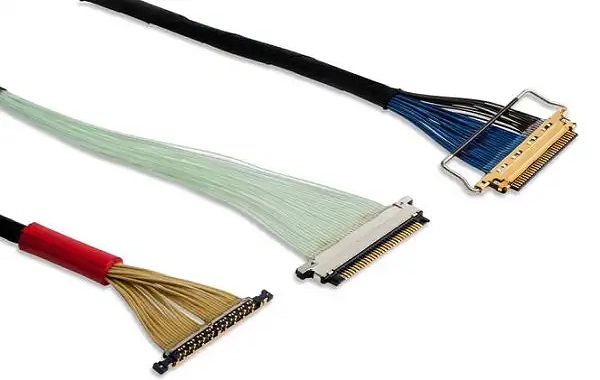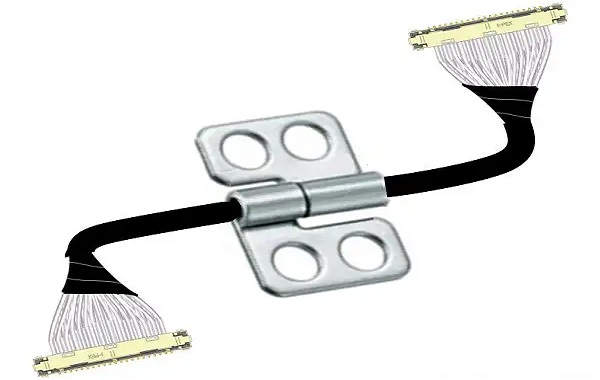Categorization:Harness Component

Fine coaxial cable束 VS High-speed flat cable
When selecting harnesses, both extremely thin coaxial harnesses and traditional high-speed flat harnesses have their respective advantages. The following comparison is made from several key aspects:
Transmission speedThe extremely thin coaxial cable bundle supports high-speed signal transmission up to 20Gbps, while traditional high-speed ribbon cables are generally 5-10Gbps. In terms of high-speed performance, the extremely thin coaxial cable bundle has a clear advantage.
Signal IntegrityThe ultra-thin coaxial cable adopts a single-core wire plus shielding design, which has strong anti-electromagnetic interference capability and can ensure stable signal transmission; while traditional high-speed ribbon cables lack effective shielding, are prone to interference, and have relatively weaker signal quality.
3. Flexibility and bendabilityThe extremely thin coaxial cable bundle can withstand over 5000 bends, making it very suitable for applications with limited space and frequent folding; high-speed ribbon cables have limited bending resistance and are prone to breaking.
4. Performance blockingExtremely thin coaxial cables support shielding at the wire core level or for the entire cable bundle, effectively reducing signal crosstalk and EMI; high-speed ribbon cables are mostly unshielded or only shielded in their entirety, with limited anti-interference capability.
Cost considerationThe manufacturing process of ultra-fine coaxial cables is complex and expensive, making them suitable for high-end products; high-speed ribbon cables are cost-effective and suitable for general applications that do not have high requirements for speed and anti-interference.
In summary, if the product has high requirements for high-speed signals, anti-interference ability, and flexible wiring, extremely thin coaxial cable bundles are undoubtedly the better choice; for low-speed and general applications, high-speed ribbon cables are still economical and practical.

Introduction to I-PEX 20532-030T-02 connector
I-PEX 20532-030T-02 belongs to the CABLINE®-UX II series, which is a very thin coaxial connector designed for high-density, high-speed signal transmission. It is commonly used in scenarios with high requirements for signal integrity, such as high-resolution screens, camera modules, vehicle systems, medical imaging equipment, and other applications.
Product Overview
• Series Model: CABLINE®-UX II / 20532 Series
• Contact spacing: 0.25 mm
• Hybrid type: Vertical insertion and extraction (90° out of line)
• Maximum height: 1.10 mm
• Matching Wire Diameter: AWG #44 to #46 ultra-fine coaxial cable
Connector type: Through-Hole installation
• Applicable cable type: for use with ultra-fine coaxial cables
Main features
Compact design: Small spacing and low height, suitable for space-limited equipment
• High flexibility and shielding performance: Supports extremely thin coaxial cables, ensuring stable high-speed signals
Multiple grounding design: enhances anti-EMI performance, suitable for applications with high requirements for signal integrity
Combined with I-PEX 20532-030T-02 and other close-spaced connectors, extremely thin coaxial cable bundles exhibit the following advantages in high-speed, high-frequency signal transmission:
Provide more stable signal transmission and anti-interference capabilitySupports frequent bending, suitable for wiring in narrow spaces
Enhance EMI control effectiveness, ensure reliable operation of high-density electronic equipment
Therefore, for applications requiring high speed, high frequency, resistance to interference, or the need for multiple bending, extremely thin coaxial cable束 can completely replace traditional high-speed cables and become a more reliable interconnection solution.

I amSuzhou Huichengyuan Electronic TechnologyLong-term focus on the design and customization of high-speed cable harnesses and ultra-thin coaxial cable harnesses, committed to providing customers with stable and reliable high-speed interconnect solutions. For more information or technical support, please contact:Manager Yin 18913280527 (WeChat number the same)。